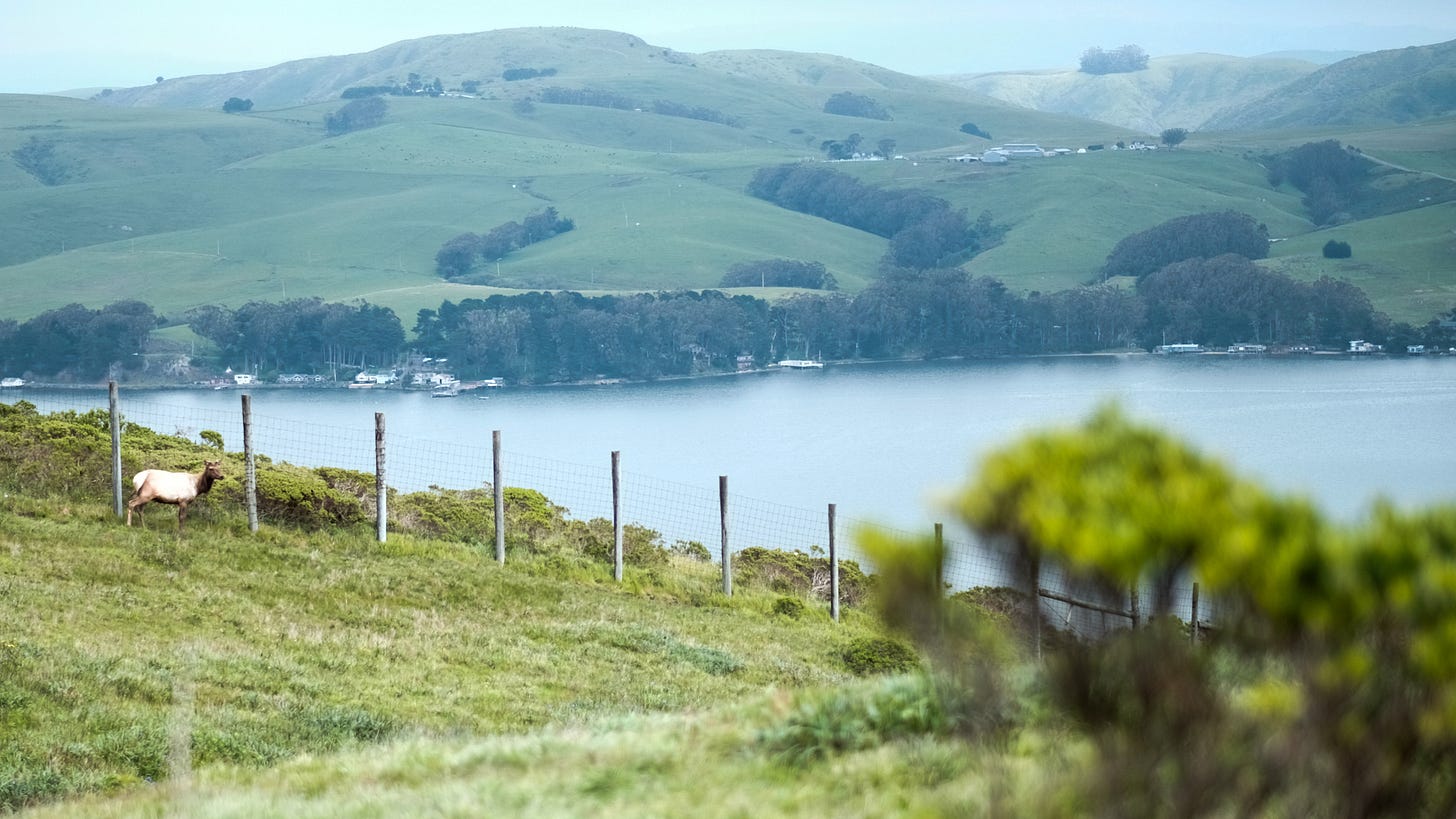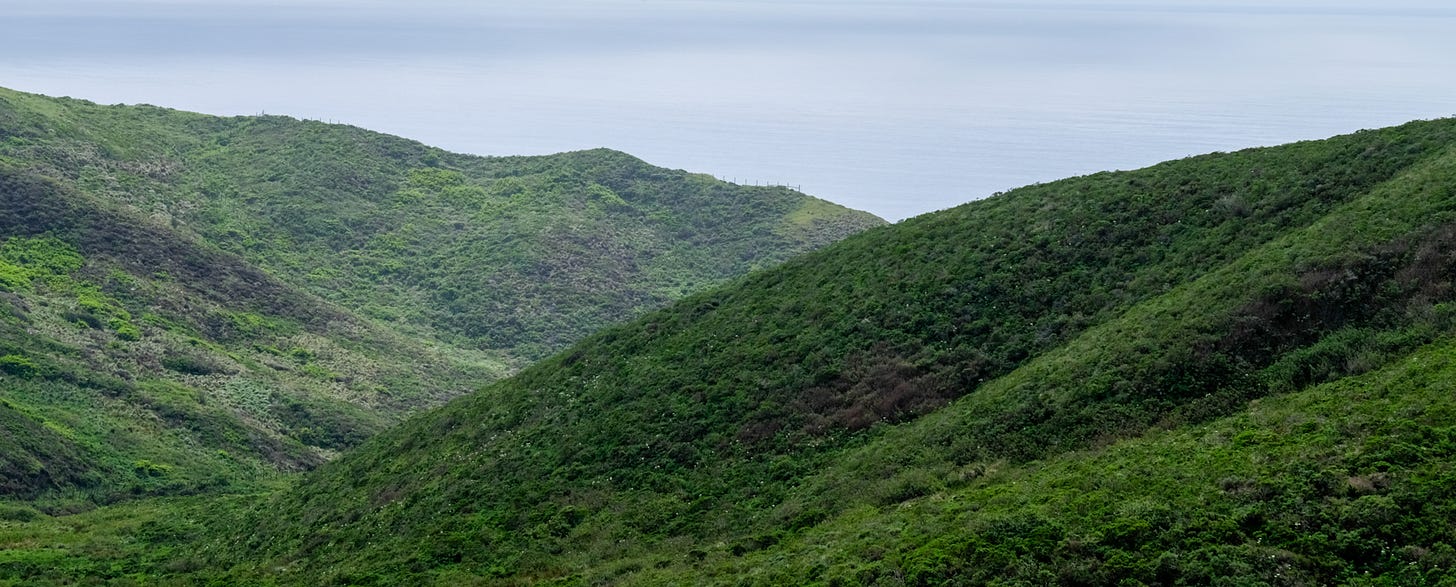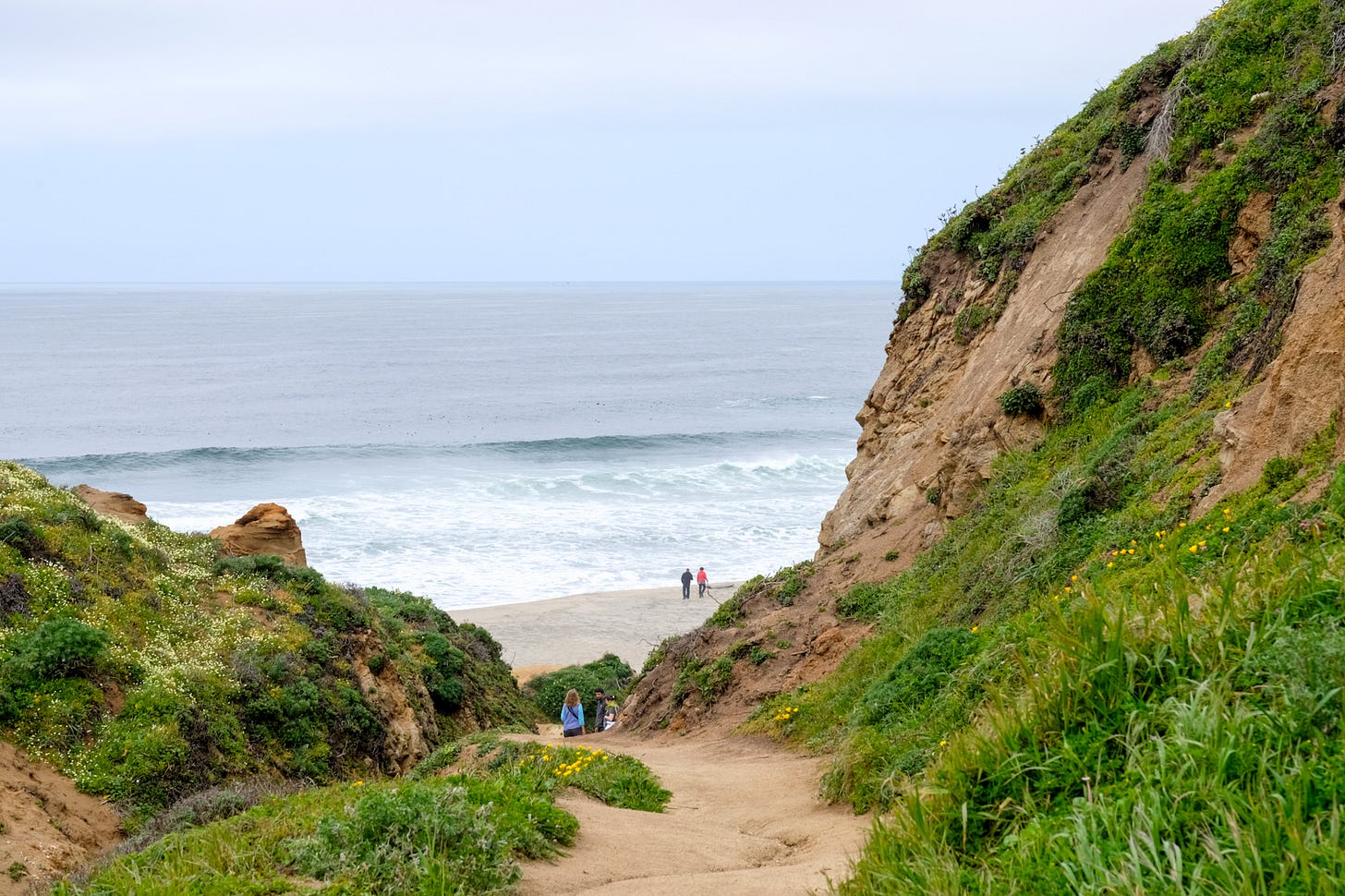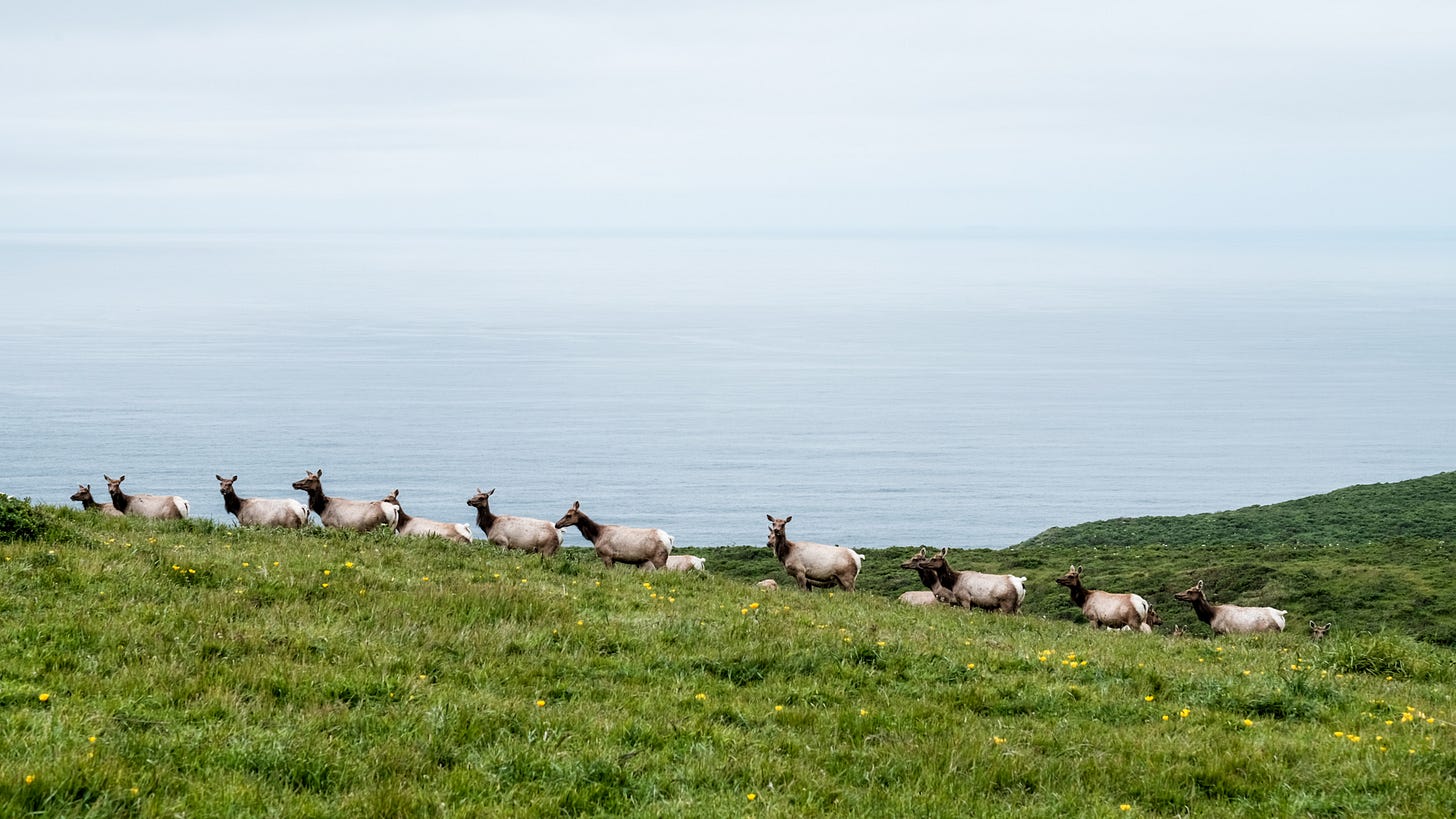Showdown at the Edge of the Continent
Environmentalists, ranchers, hikers, tule elk, and red-legged frogs flght for a permanent place in Point Reyes National Seashore
The story, written in 2017, is about a long-running dispute between environmentalists and ranchers at the Pt. Reyes National Seashore over, basically, what is wilderness, parkland, and farmland. I’ve always loved Pt. Reyes, so this piece was close to my heart.
Recently,the feud was settled, with the help of the Nature Conservancy, which bought out the farmers whom the environmental groups had hoped would just go packing. Now, most of the cattle and dairy ranches that have inhabited the peninsula since the Spanish land grants will depart, leaving more land to hikers and wildlife. Still, many of the ranchers are unhappy. As Michael Straus, who has bought organic milk from ranchers there for his dairy, put it, “the settlement is a disaster for the entire West Marin community. The ranchers were run out, beaten down by years of litigation, and eventually acquiesced to a settlement that none wanted.”
The ranchers were stewards of the land for generations. After all those years, I think I’ll miss seeing cows while I hike in Pt. Reyes.
This piece has a lot of history of the peninsula, including why the trademark for Pt. Reyes is a red star, how those herds of albino deer and tule elk got there, and why the gorgeous peninsula isn’t full of housing developments. If you’ve never been to Pt. Reyes, it’s well worth the trip next time you’re in San Francisco —and just an hour north.
These photos are by my friend Andrew Sullivan, who drove up there with me to get photos of tule elk after San Francisco magazine miscaptioned a photo of a group of deer as elk. They ran it that way anyway.
Every spring I like to hike in Point Reyes National Seashore, among the fields of purple Douglas iris on the Estero Trail. Wandering along the rolling grasslands, I can almost imagine the landscape as pristine wilderness. The only obvious signs of human interference are a cluster of Monterey pines (remnants of an old Christmas tree farm) and a bridge that used to overlook submerged oyster beds, now gone. After a controversy that shook and divided Marin County like the seismic fault that separates Point Reyes from the rest of North America, the oysters were removed by the US National Park Service in 2015 and 2016 as part of an effort to re-create wilderness. So now the view from the bridge looks more like what the native Miwok must have roamed around in. Here, a mere hour’s drive north of San Francisco, I can revel in pure, untrammeled nature.
Until I see a cow. A whole herd of them, actually, mooing and slopping around in the mud, leaving hoof prints and oozing dung pies near my trail. The cattle, from the nearby N Ranch, are disrupting my weekend wilderness fantasy. It would be scenic and appropriately wild to spot a bobcat or a tule elk out here, but cows? They’re just annoying.
Of course, cows are no recent interlopers in Point Reyes. It was during the gold-rush 1850s that white settlers realized that the 11-square-mile peninsula’s lush, fog-soaked grasslands were perfect for grazing cattle. The Miwok, who had lived here for thousands of years, burned the land to create open, grassy hunting grounds for tule elk, which white settlers and Mexican rancheros hunted to near extinction. When hordes of hungry 49ers arrived in San Francisco, a couple of enterprising attorneys, James and Oscar Shafter, set up a dairy empire in Point Reyes. the brothers had acquired much of the peninsula after tangled litigation over claims and sectioned it into 33 dairies, many named after letters of the alphabet (A Ranch, B Ranch, and so on). The Shafters’ alphabet dairies, run by European immigrant tenants with the help of a few remaining Miwok, made butter and farmed hogs. Everything was loaded onto a schooner once or twice a week and shipped to San Francisco. The fresh butter was so luscious that others counterfeited its star trademark.
So the cows were here long before we hikers, and a full century before Point Reyes was permanently preserved from encroaching development under legislation signed by President John F. Kennedy in 1962. By the Kennedy years, most of the ranching families on the peninsula were struggling: California’s growing commercial dairy industry, along with high, residential-rate taxes and pressures of suburban growth (a subdivision had already been carved out of the hills above Limantour Beach), were making the economic survival of family farms precarious. That’s why, in the 1970s, the owners were willing to sell their ranches to Point Reyes National Seashore in a deal that would allow the ranchers to stay for at least 20 years, with the tacit understanding that two decades could well turn into forever, thanks to the National Park Service’s habitual granting of extensions of up to five years. Some of the ranchers eventually cleared out, but 15 families (and the people who work for them) remain: six organic dairies and the rest cattle ranches, many fourth- or fifth-generation on the land.
What, exactly, we want our wilderness to be? Should we be preserving a landscape of the past that may, in actuality, have never existed?
But now, after half a century of mainly peaceful coexistence with the park, the ranches are under threat. Point Reyes’s legacy ranchers face the possibility of being kicked off the land (or simply starved out) by an ongoing lawsuit filed by environmental groups seeking to block the Park Service from renewing the ranchers’ leases. These groups—the Arizona-based Center for biological Diversity, Mill Valley’s Resource Renewal Institute, and the Idaho-seated Western Watersheds Project—claim that Point Reyes’s cows are causing environmental damage and interfering with recreation.
To the casual observer, their contentions are hard to dispute. One sight of a methane-belching beast on an otherwise idyllic hike can convince anyone that the cattle are despoiling the land. But left unanswered is what, exactly, we want our wilderness to be. Should we be preserving a landscape of the past that may, in actuality, have never existed? Or should we be encouraging responsible stewardship of a “working landscape,” even one that happens to lie within one of the most naturally resplendent public properties in all the land?
Oddly, what first prodded the environmental groups’ lawsuit against the ranchers had nothing to do with cattle. It all began with a fight over oysters. Though oysters had been farmed in Drakes Estero since the 1930s, the Drakes Bay Oyster Company was designated to close under the Point Reyes Wilderness Act of 1976 after its 40-year lease—technically called a reservation of use and occupancy—expired in 2012. Rancher Kevin Lunny bought the oyster farm in 2005, invested heavily in cleaning it up, and hoped to get the reservation extended. However, in 2014, then-US interior secretary Ken Salazar decided that the company’s reservation would not be renewed. A bitter fight between two Marin factions—oyster farmers vs. environmental groups who wanted the Park Service to end its leasing arrangement with the Drakes Bay Oyster Company—went national, with Alice, Waters, Senator Dianne Feinstein, and Michael Pollan siding with the oysterers, and both local and national environmental groups fighting for the end of oyster farming on Point Reyes. In the end, the decision stood. A deal was a deal, and the oyster farm closed.
If oysters could be evicted, why not cows?
But the decision cracked open a new possibility for the victors: If oysters could be evicted, why not cows? Salazar, a former Colorado rancher, was careful to address that concern in his memo, underscoring the “importance of sustainable agriculture on the pastoral lands within Point Reyes.” The ranches, unlike the oyster-rich estero, had never been designated as wilderness, and so Salazar directed the Park Service to give the ranching families 20-year lease extensions.
The Park Service set about the process of extending the reservations, which, under the National Environmental Policy Act, requires public input and an environmental assessment. This stage sparked a whole new conversation, this time about the pasturelands of tule elk as well as hiking access, farm tours, historic structures, endangered species, and a wide range of other conservation issues. National environmental groups organized hundreds of identically worded emails that opposed cattle grazing. In February 2016, the environmental groups sued, halting the ranch planning process. They requested that the Park Service develop a new general management plan instead, which, they hoped, would move the debate from how the ranches should be managed to whether they should exist at all. “This is not necessarily a call for the end of ranching,” says Chance Cutrano of the Resource Renewal Institute, on of the suit’s plaintiffs. “But before locking grazing in for 20 years without considering the needs of wildlife, climate change, or drought on the park, we thought we should take a step back.”
The effort has split the environmentalist world in two. Gordon Bennett, president of Inverness-based Save Our Seashore, was opposed to the Drakes Bay oyster lease extension but he has resisted falling behind the pro-wilderness advocates this time around. “They’re not trying to improve the ranches—that’s bullshit,” he says. “They’re trying to get rid of the ranches.” Bennett, a former member of the Federal Parks Commission who has often been on the same side as the plaintiffs over the years, characterizes them as “anti-grazing activists” who have taken their “valid” experiences fighting overgrazing in the Southwest and mistakenly tried to apply them to the Point Reyes National Seashore.
Indeed, plaintiff Huey Johnson, founder of the Resource Renewal Institute—an environmental éminence grise who also founded the Trust for Public Land—has said that if the suit is successful, the coalition plans to try to remove livestock from some of the other roughly 30 national parks that allow grazing. “There are pastures out there that don’t have any green thing on them, just mud and manure,” he told the San Jose Mercury News. “You’ve got welfare ranching going on public lands all over the West.”
“This is Point Reyes. This was once the butter capital of California, grazing heaven.”
It’s true the parks are supposed to belong to us, the taxpayers, but it’s not entirely clear that federally subsidized “welfare ranching”—the kind that bolsters failing ranches in the arid Southwest—is really going on in verdant Marin. David Lewis, county director of the UC Cooperative Extension in Marin County, estimates that the Point Reyes ranches contribute 17 to 20 percent of the county’s $110 million in annual agricultural production. Given the industries that support agriculture—feed companies, veterinary services, a grass-fed beef butchery—the overall economic output of the ranches may be three times that amount. If the ranches closed, Lewis says, “You’d be losing about $60 million a year in production:
Then there are jobs. For every farm job, there are up to four off the farm, with the ranches contributing a total of about 5,384 jobs to the North Bay, per the 2012 census. The ranchers pay $7 per cow for annual grazing rights, adding about $500,000 a year to the park’s coffers, and they pay property taxes to the county on top of that. So important are the ranches to the West Marin economy that county supervisors voted to provide 20 percent of their legal fees (with a $200,000 cap) to support the ranches. “Losing 6 of our 25 dairy farms in Marin County would be disastrous,” says Albert Straus, who owns Straus Family Creamy, which gets some of its organic milk from a Point Reyes dairy. “Not just losing the farms, but long time neighbors, schools, support services—the whole fabric of the community would suffer.” As for the environmental destruction wrought by grazing in national parks? Bennett has a concise response to such concerns: “This is Point Reyes. This is completely different. This was once the butter capital of California, grazing heaven.”
Animals have grazed on the grasses of Point Reyes since time immemorial, but which animals have the right to graze there now? Enter the tule elk. Cutrano says that the lawsuit has less to do with leveraging the oyster controversy to evict the cows than with ore urgent concerns over a drought-induced tule elk die-off from 2012 to 2014, when the population of the rare animals on Tomales Point dropped from 540 to 286. “They were fenced in an area with insufficient water and forage to protect dairy ranches from their incursion while not a single cow died,” the plaintiffs alleged in a statement. “That’s inhumane.”
Park management doesn’t feed and water the elk. “This isn’t a zoo,” says Point Reyes National Seashore spokesperson Melanie Gunn, who would not comment on the lawsuit. But while the fenced-in elk declined during the drought, the population of free-ranging elk herds in other parts of the park grew. In Cutrano’s view, if the Tomales elk had been free to graze the entire park—including the ranches, without competing with cows for the grass—fewer would have died.
Park management doesn’t feed and water the elk. “This isn’t a zoo,” says Point Reyes National Seashore spokesperson Melanie Gunn.
The tule elk were once hunted to near extinction: By the 1870s, only 30 remained, on a ranch near Bakersfield. They were reintroduced to the park in 1978, when 10 elk were transferred to a fenced enclosure on Tomales Point. The elk thrived, particularly in the absence of their ancestral predators, grizzly bears and humans. (The few mountain lions in Pt. Reyes have enough deer to eat to not bother muscling down an elk.) In 1998, as the elk population grew, the Park service transferred 28 animals to the Limantour wilderness area. Two of those free-ranging elk, no fools, jumped the fence from the shrubs to the grassy pastoral land, where they enjoyed grass intended for cattle. Ranchers complained that the tule elk were costing them precious forage; under organic standards, ranchers must feed cattle a high percentage of grass to stay certified. Nichola Spaletta, whose C Ranch had the most rogue elk, complained that the elk were actually endangering the long-term survival of the organic farms, not hte other way around. She added, diplomatically, “There is a place for the cattle and a place for the elk both in this beautiful Point Reyes National Seashore.” the plaintiffs aren’t buying it. “We are very concerned that commercial cattle operations take priority over the tule elk when the two come into conflict,” they wrote.
Lynn Huntsinger, professor of rangeland ecology and management at UC Berkeley, isn’t nearly as concerned about dips in the elk population. The cattle question is ore or less irrelevant, she says—without predators, tule elk will take over the whole peninsula: “They will eventually breed until there’s no space left for them.” The healthiest herds of rule elk live on wildlife refuges and are hunted, Huntsinger says. But in Marin, environmentalists of all stripes would be up in arms at the hint of hunting, even if plenty of them, like me, would happily eat grass-fed elk, cooked medium rare with a pinot noir reduction sauce. The elk may be the impetus for the lawsuit, but they’re also a bit of a red herring. There are other ways to manage the elk, including contraception; “hazing,” or shooing them away from ranch areas; and culling which the Park Service knows how to do. In 2006, the park controversially used sharpshooters in helicopters to exterminate its non-native deer (purchased from the San Francisco Zoo for hunting in the 1940s) and gave the meat to local food banks.
In Marin, environmentalists of all stripes would be up in arms at the hint of hunting, even if plenty of them, like me, would happily eat grass-fed elk, cooked medium rare with a pinot noir reduction sauce.
Aside from the elk, the plaintiffs have more general complaints about grazing: They contend that ranching erodes the soil, fences the public out of large parcels of the park, contributes (via methane) to greenhouse gases, pollutes the water, impedes the natural migration of wildlife, and “presents visitors with large and unsightly processing facilities and mobile homes.” Cutrano says that cattle also interfere with recreation: “People are frightened by barbed wire fences.” (Under park rules, visitors are free to hike wherever cattle graze, though it is polite to clase the gate behind you.)
None of this is entirely new. Debates about grazing, the environment, and land use in the park are as thick and long-standing as the poison oak on Inverness Ridge. Local ranchers have long contended that there is good grazing and bad grazing, just as you can slather pesticides on row crops or grow them organically. Defending Beef: The Case for Sustainable Meat Production author Nicolette Hahn Niman, an environmental lawyer who lives on a cattle ranch in Bolinas (she and her husband, Bill Niman, own all-natural BN Ranch meats), says it’s all about where and how you graze. “the idea that cattle are inherently bad doesn’t make sense when you’re out on the land,” she says. Like many other West Marin farming operations, hers is a model of sustainability. Her cattle live year-round on grass, not grain, and the ranch does no plowing, planting, chemical applications, or irrigation. The animal waste goes back into the pastures, returning moisture and vegetation to the soil. Trampling the soil helps break it up so the grasses can thrive and the cows are rotated to keep the soil and grasses at their peak.
Hahn Niman says the irony of hte anti-grazing lawsuit is that it’s keeping her neighbors from being the best environmental stewards they can be: “Ranchers have to spend time and money responding to legal claims versus putting resources into taking good care of the land.” West Marin has been an incubator for sustainable farming projects such as methane digesters, which divert cow manure from poluting streams to powering diaries, and carbon farming, which improves soil while trapping carbon in comost instead of releasing it into the atmosphere. But ranchers who are uncertain of their future can’t afford to make costly sustainability investments like these.
Near the turnoff to the Estero Trailhead is a ranch house lived in by David Evans, a fourth-generation ranchers whose family sold its land to the seashore in 1971; he was born the next year. “I grew up knowing we didn’t own the barns we had built, and despite all the government officials at our breakfast table telling us how important we were to Point Reyes National Seashore, if the political winds changed, we could be gone,” he says. That uncertainty might have deterred some kids, but Evans dug in. “I decided this was a unique opportunity to be a great rancher, to manage public land for the correct use in a private and public partnership,” he says.
Evans founded Marin Sun Farms, a sustainable beef company; he bought the last slaughterhouse in the Bay Area and made it organic, and he sells locally grown products at his restaurant and butchery in Point Reyes Station. His wife, Claire Herminjard, founded Mindful Meats, which markets grass-fed, humanely raised organic dairy cattle and has worked to get organic meats into public schools.
Being a rancher on parklands gives Evans special responsibilities. “I manage endangered red-legged frog habitat as part of my grazing operations,” he says. He pulls invasive species, like Scotch broom. He rotates his cattle so that they don’t disturb nesting birds, and he mows his fields in a pattern that allows wildlife to escape. “We’re passionate about doing an exemplary job of managing this working landscape,” he says.
We drive to meet a neighbor, winding along the road toward Tomales Point, hills emerald green from the rains. We spot a few irises along the roadside. “This landscape is getting ready to erupt,” Evans says. “It goes crazy with wildflowers, which is due to the grazing.” We turn off at the I Ranch, which has been a dairy for 170 years, organic for 10. There we greet Bob McClure, whose family donated McClure’s Beach to the county in the 1940s. “I always say I’m the fourth generation of someone not smart enough to do something else,” McClure says. I take in the view of velvety hills and shimmering ocean and comment that it’s so gorgeous here that he seems plenty smart to me, and he nods.
McClure shows me around his shiny milking facility, which he refurbished for $400,000 several years ago, and tells me that this is “probably the most expensive dairying area in the United States.” Costs of labor, electricity—everything is high. His barn is piled with organic feed, bought at the exorbitant price of $1,200 per ton. He’s nervous about losing it all should the environmental suit prevail, but he says, “You have to be optimistic to be a farmer.” He hopes that a compromise will be reached. “We can talk things through with reasonable environmental people,” he says. “It’s not just our place anymore. This is public, and we get that.”
Evans and I wave goodbye and drive farther out, to Tomales Point, passing a big bull elk with his harem. He tells me he wishes the Park Service would make more out of hte landscape heritage in Point Reyes; he’d like to do farm tours, to show kids that milk and hamburgers don’t come from packages. “We have a big food-geek culture in the Bay Area, and people want to know what’s going on,” he says. The ranches, he notes, give urbanites a chance to connect with their food and the people who produce it. “Recreation isn’t just floating in a kayak or standing in the surf, but interacting with a different way of life,” he says.
We talk for a while about the recent election. The political winds may turn in favor of the ranchers; it’s unlikely the current secretary of the interior, Ryan Zinke, would have evicted the Drakes Bay oyster farm as his Obama administration predecessor did. But what might happen to working public lands under this administration—even privatization—is anyone’s guess. Evans is still worried, although he sees in Marin’s ranchlands a chance to narrow some of our nation’s gaping divides between urban and rural people. “What we have right here is connective tissue,” he says. “It’s a scarce interaction.”
we stop at the crest of a hill overlooking Tomales Bay and gaze down at the Pierce Point Ranch. The white, renovated historic farm buildings are empty. If the suits litigants prevail and the ranchers are forced out like the oysterers before them, the grasslands where they’ve grown food, ever more sustainably, will be taken over by shrubs. Along with the cows, the irises will go away. The ranching heritage will be reduced to a museum of farming in the middle of a “wilderness” that bears little trace to the people who lived and grazed or hunted animals here for millennia.
What seems certain is that this lawsuit, however it is resolved, will not be the last of the skirmishes. Point Reyes has been fought over since the gold rush. It is both priceless and productive, a place of refuge and revenue. The fault lines won’t disappear; they’ll just rumble and shift. In the meantime, it’s a glorious lace to go for a hike, and to spot an organic grass-fed cow—in the wild.
San Francisco, May 2017
Keep reading with a 7-day free trial
Subscribe to The Phrazer to keep reading this post and get 7 days of free access to the full post archives.









